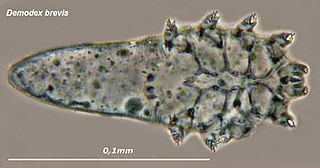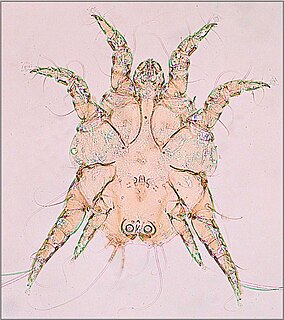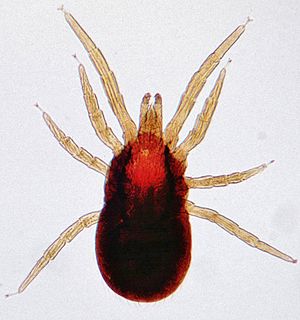
Folliculitis is the infection and inflammation of one or more hair follicles. The condition may occur anywhere on hair covered skin. The rash may appear as pimples that come to white tips on the face, chest, back, arms, legs, buttocks, or head.

Mange is a type of skin disease caused by parasitic mites. Because mites also infect plants, birds, and reptiles, the term "mange" or colloquially "the mange", suggesting poor condition of the hairy coat due to the infection, is sometimes reserved only for pathological mite-infestation of nonhuman mammals. Thus, mange includes mite-associated skin disease in domestic animals, in livestock, and in wild animals. Since mites belong to the arachnid subclass Acari, another term for mite infestation is acariasis.

Demodicosis, also called demodectic mange or red mange, is caused by a sensitivity to and overpopulation of Demodex spp. as the host's immune system is unable to keep the mites under control.

An eyelash or simply lash is one of the hairs that grows at the edge of the eyelid. It grows in one layer on the edge of the eyelids. Eyelashes protect the eye from debris, dust and small particles and perform some of the same functions as whiskers do on a cat or a mouse in the sense that they are sensitive to being touched, thus providing a warning that an object is near the eye.

Demodex is a genus of tiny mites that live in or near hair follicles of mammals. Around 65 species of Demodex are known. Two species live on humans: Demodex folliculorum and Demodex brevis, both frequently referred to as eyelash mites, alternatively face mites or skin mites. Different species of animals host different species of Demodex. Demodex canis lives on the domestic dog. The presence of Demodex on mammals is common and usually does not cause any symptoms, although occasionally some skin diseases can be caused by the mites. Demodex is derived from Greek δημός dēmos "fat" and δήξ dēx, "woodworm".

Demodex folliculorum is a microscopic mite that can only survive on the skin of humans. Most people have D. folliculorum on their skin. Usually, the mites do not cause any harm, and are therefore considered an example of commensalism rather than parasitism. If D. folliculorum does cause disease, this is known as demodicosis.

Demodex brevis is one of the two species of face mite that inhabit humans. They are very similar to Demodex folliculorum, with just a few differences. They are usually found in the sebaceous glands of the human body. The same way that D. folliculorum reproduces in the follicles, D. brevis reproduces in the sebaceous glands. Under normal conditions they are not harmful, and are considered to be commensals rather than parasites or symbionts. During a severe infestation, though, there may be adverse effects on the host, such as demodicosis.

Mites that infest and parasitize domestic animals cause disease and loss of production. Mites are small invertebrates, most of which are free living but some are parasitic. Mites are similar to ticks and both comprise the order Acari in the phylum Arthropoda. Mites are highly varied and their classification is complex; a simple grouping is used in this introductory article. Vernacular terms to describe diseases caused by mites include scab, mange, and scabies. Mites and ticks have substantially different biology from, and are classed separately from, insects. Mites of domestic animals cause important types of skin disease, and some mites infest other organs. Diagnosis of mite infestations can be difficult because of the small size of most mites, but understanding how mites are adapted to feed within the structure of the skin is useful.
Demodex bovis, also known as the cattle follicle mite, usually causes demodicosis, or demodectic mange, in cattle. This disease is common in tropical areas and is not usually found in temperate environments. Demodicosis is characterized by the formation of papules and nodules over the cattle's skin. These lesions most commonly occur on the neck, shoulders, and armpit of cattle; however, sometimes they also appear on the udder. This condition is often found in cattle with increased stress from pregnancy or lactation. Natural and acquired immunity can cause a decrease in the number of mites infesting a cow, as well as decreasing the severity of a cow's symptoms.

Mites are small crawling animals related to ticks and spiders. Most mites are free-living and harmless. Other mites are parasitic, and those that infest livestock animals cause many diseases that are widespread, reduce production and profit for farmers, and are expensive to control.
Demodex conicus is a hair follicle mite found in the ear canal of the house mouse, Mus musculus.
Demodex microti is a hair follicle mite from the skin of the genital area of the common vole, Microtus arvalis.
Demodex criceti is a hair follicle mite found in the epidermis of the Syrian hamster, Mesocricetus auratus.
Demodex gatoi is a hair follicle mite from the skin surface of the domestic cat, Felis silvestris. It is the second described species of Demodex from the domestic cat, and is distinguishable from Demodex cati by being shorter and rounder.
Demodex gapperi is a hair follicle mite found in the eyelids of the red-backed vole, Clethrionomys gapperi.
Demodex huttereri is a hair follicle mite found in the Meibomian glands of the striped field mouse, Apodemus agrarius.
Demodex ponderosus is a hair follicle mite found on thinly haired regions of the brown rat, Rattus norvegicus.
Demodex foveolator is a hair follicle mite found in epidermal pits of the lesser white-toothed shrew, Crocidura suaveolens.
Demodex leucogasteri is a hair follicle mite found in the hair follicles of the grasshopper mouse, Onychomys leucogaster.
Demodex cyonis is a species of Demodex mite first circumscribed in 2018 after being detected in the earwax of a dog with otitis externa in Saitama Prefecture, Japan, in July 2010. It was determined to be a new species based on morphological characters including its opisthosoma length being shorter than one-half its body length, differentiating it from the other species in domestic dogs, D. canis and D. injai, and similar “short-bodied species” such as D. cornei. It is morphologically most similar to D. equi and D. acutipes. The specific epithet cyonis is derived from the Greek word for domestic dog, κύων, the first observed host animal.







